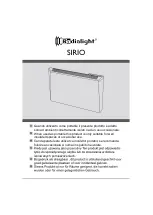
lp-32 Rev. 003 Rel. 010 Date 2.22.19
7
G. Applications
Figure 3 - Typical Storage Tank Installation - SSU-20CB - SSU-60CB Models Figure 4 - Typical Storage Tank Installation - SSU-80CB and SSU-119CB
Models
PIPING NOTES:
The following notes are applicable to all of the piping applications demonstrated on this page.
1. Check valves are optional. Circulators may have Internal Flow Checks (IFCs).
2. If a backflow preventer or no return valve is installed a thermal expansion tank suitable for potable water must be sized and installed on the
cold water inlet between the storage tank and the backflow preventer.
Part 4 - Control and Wiring
A. Control
A pre-wired surface mount thermostatic control is provided on your
storage tank. Temperature may be set by removing lower cover
screw and lower cover. has been provided for accurate temperature
adjustment.
B. Wiring
Wiring is to be done in accordance with all applicable local and state
codes. Turn off all power related to the water heating system before
starting any wiring procedures. It is recommended that a disconnect
switch be installed between the boiler control and the storage tank.
When wiring the controls be sure to label all wires to ease future
maintenance. Wiring errors can cause improper and dangerous
operation.
C. Wiring Diagram
Figure 5 - Wiring the Control
1. Fill the storage tank by opening the cold water shut-off valve.
Make certain any drain valves are completely closed. Purge air from
the system by opening a hot water outlet at a fixture in a kitchen or
bathroom. When water flows freely from the outlet, the system is
purged.
Part 5 - Start-Up and Operation
When filling the storage tank, open a hot water tap to release air in
the tank and piping to ensure proper storage tank operation. Failure
to ensure the storage tank is full before turning on the system could
result in damage to the water heating system and property damage.
Such damages ARE NOT covered by warranty.
2. Check the system for leaks.
Fix any leaks before continuing the installation. Failure to do so could
result in property damage or personal injury.
3. After ensuring there are no leaks within the system, flush the system
to clear any soldering residue. Many soldering fluxes contain Zinc
Chloride, which can corrode stainless steel.
Draw at least three times the volume of the storage tank to properly
flush the system.
4. Initiate a call for hot water. Ensure each zone valve or circulator
operates only when its thermostat calls for heat. Purge each zone of air
to ensure proper operation.
5. Set the storage tank to the desired temperature. Boiler high limit
should be set at least 20
o
F higher than the storage tank temperature
setting. Set the low limit of the control at the minimum setting - this
will call the burner on only to satisfy the tank control.
A storage tank temperature setting of 120
o
F is recommended.
However, a lower temperature setting may be required to comply with
local and state codes for normal operation. Installation conditions
may require a higher or lower temperature setting. A mixing valve in
conjunction with a high temperature setting may be used for high






























